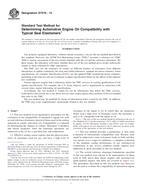Potrebujeme váš súhlas na využitie jednotlivých dát, aby sa vám okrem iného mohli ukazovať informácie týkajúce sa vašich záujmov. Súhlas udelíte kliknutím na tlačidlo „OK“.
ASTM D7216-13
Standard Test Method for Determining Automotive Engine Oil Compatibility with Typical Seal Elastomers
Automaticky preložený názov:
Štandardná skúšobná metóda pre stanovenie Automotive motorového oleja Kompatibilita s typickými Seal elastomérov
NORMA vydaná dňa 15.6.2013
Informácie o norme:
Označenie normy: ASTM D7216-13
Poznámka: NEPLATNÁ
Dátum vydania normy: 15.6.2013
Kód tovaru: NS-37898
Počet strán: 12
Približná hmotnosť: 36 g (0.08 libier)
Krajina: Americká technická norma
Kategória: Technické normy ASTM
Anotácia textu normy ASTM D7216-13 :
Keywords:
automotive engine oil, compatibility, elastomer, engine oil, immersion, seal(s), ICS Number Code 75.100 (Lubricants, industrial oils and related products)
Doplňujúce informácie
| Significance and Use | |||||||||||||||||||||||||||||||||||||||||||||||||||||||
|
5.1 Some engine oil formulations have been shown to lack compatibility with certain elastomers used for seals in automotive engines. These deleterious effects on the elastomer are greatest with new engine oils (that is, oils that have not been exposed to an engine’s operating environment) and when the exposure is at elevated temperatures. 5.2 This test method requires that non-reference oil(s) be tested in parallel with a reference oil, TMC 1006-1, known to be aggressive for some parameters under service conditions. This relative compatibility permits decisions on the anticipated or predicted performance of the non-reference oil in service. 5.3 Elastomer materials can show significant variation in physical properties, not only from batch-to-batch but also within a sheet and from sheet-to-sheet. Results obtained with the reference oil are submitted by the test laboratories to the TMC to allow it to update continually the total and within-laboratory standard deviation estimates. These estimates, therefore, incorporate effects of variations in the properties of the reference elastomers on the test variability. 5.4 This test method is suitable for specification compliance testing, quality control, referee testing, and research and development. 5.5 The reference elastomers, reference oil and the physical properties involved in this test method address the specific requirements of engine oils. Although other tests exist for compatibility of elastomers with liquids, these are considered too generalized for engine oils. |
|||||||||||||||||||||||||||||||||||||||||||||||||||||||
| 1. Scope | |||||||||||||||||||||||||||||||||||||||||||||||||||||||
|
1.1 This test method covers quantitative procedures for the evaluation of the compatibility of automotive engine oils with several reference elastomers typical of those used in the sealing materials in contact with these oils. Compatibility is evaluated by determining the changes in volume, Durometer A hardness and tensile properties when the elastomer specimens are immersed in the oil for a specified time and temperature. 1.2 Effective sealing action requires that the physical properties of elastomers used for any seal have a high level of resistance to the liquid or oil in which they are immersed. When such a high level of resistance exists, the elastomer is said to be compatible with the liquid or oil. 1.3 This test method provides a
preliminary or first order evaluation of oil/elastomer
compatibility only. Because seals might be subjected to static or
dynamic loads, or both, and they can operate over a range of
conditions, a complete evaluation of the potential sealing
performance of any elastomer-oil combination in any service
condition usually requires tests additional to those described in
this test method.
1.4 The several reference elastomer formulations specified in this test method were chosen to be representative of those used in both heavy-duty diesel engines and passenger-car spark-ignition engines (the latter are covered in 1.5 The values stated in SI units are to be regarded as standard. No other units of measurement are included in this standard. 1.6 This standard does not purport to address all of the safety concerns, if any, associated with its use. It is the responsibility of the user of this standard to establish appropriate safety and health practices and determine the applicability of regulatory limitations prior to use. 1.7 This test method is arranged as follows:
|
Odporúčame:
Aktualizácia technických noriem
Chcete mať istotu, že používate len platné technické normy?
Ponúkame Vám riešenie, ktoré Vám zaistí mesačný prehľad o aktuálnosti noriem, ktoré používate.
Chcete vedieť viac informácií ? Pozrite sa na túto stránku.




 Cookies
Cookies
